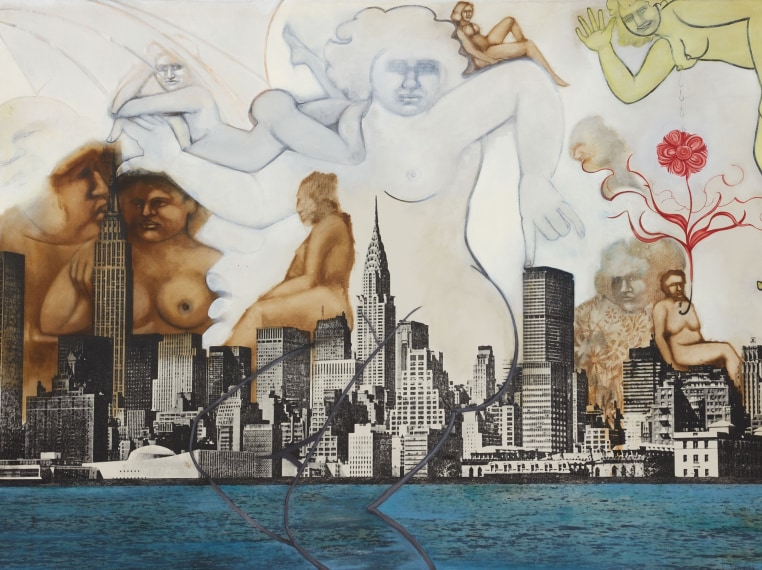
ANITA STECKEL: MY TOWN
May 17 – July 16, 2022
Ortuzar Projects is pleased to present Anita Steckel: My Town, the artist’s first solo exhibition in New York since 2013. An artist, teacher, feminist, and satirist, Anita Steckel (b. 1930, Brooklyn; d. 2012, New York) experimented liberally across media—from pencil and oil to collage, photomontage, silkscreen, Xerox, assemblage sculpture, and poetry—in an exploration of the sexism of Western art history and the prudishness of postwar American society. The exhibition will present her best known works from the late 1960s through the early 70s, which address taboo notions of female pleasure and eroticism, as well as her lesser-known, earlier drawings and paintings.
A lifelong New Yorker, much of Steckel’s work reflects on women’s experience of modernity set within the urban landscape. Drawing upon popular culture, politics, and her own biography, Steckel developed her uniquely sardonic voice amongst the thriving downtown scene of the 1950s and 60s in close dialogue with fellow collagists such as Allen Ginsberg, Ray Johnson, Stan VanDerBeek, and Sari Dienes. In an intimate series of works from the 1960s, Steckel explores the division between the public-facing roles women were expected to perform and the rich complexity of their interior lives. In The Big Rip-Up (1964) she overpaints a black-and-white photograph of herself as a teenager, her youthful yet deliberate gaze out towards the viewer subsumed by a copulating crowd of nude bodies and contorted faces rendered in graphite, her right eye bloodshot and crying a technicolor stream of tears. In a series of works on paper, which were included in her first solo exhibition in 1961, she creates Rorschach tests by folding papers blotted with brown ink, out of which she draws ghoulish expressions. In oil paintings made in the second half of the decade, outlines of women’s profiles are filled with kaleidoscopic arrays of nude forms, whose bodies swirl across the canvas like thoughts going through one's head. Appearing both claustrophobic and anxious, sensuous and seemingly carefree, Steckel’s women give form to the tension between the only burgeoning women’s liberation movement and the still pervasive constraints of patriarchy.
In Giant Women on New York (c. 1969–74), female colossus tower over spaces typically ruled by social decorum. While initially painted, Steckel later adorned these work with her own face in an innovative use of photomontage and self representation. The works vary from bitingly political–such as in Murder by Church Sanctioned Illegal Abortion, in which she is crucified within what appears to be Saint Patrick’s Cathedral–and humorous, such as in another simply titled Subway, in which she sits topless between two men, masturbating herself with one hand and the man to her right with the other. Inspired by her regular exposure to flashers on the subway as a teen, these playful yet divisive works were met with great fanfare when first shown at the Kozmopolitan Gallery in 1969. In her next body of work, the monumental New York Skyline series (1970–80), silkscreened views of the city are overpainted with dancing and distraught bodies, a sphinx, and fluid-spurting penises and breasts, giving form to the vivid libidinal landscape that resides within the visible architectural one.
When Steckel showed these works in a 1972 solo exhibition at Rockland Community College, pointedly titled The Feminist Art of Sexual Politics, she was met with impassioned debate around her work’s perceived eroticism, with calls from local politicians to close the show on the grounds of obscenity. Spurring support from the university community, critics, curators, and fellow artists who argued that the shock value of her images was a fundamental part of their artistic merit and intellectual power, Steckel rallied female colleagues—including Louise Bourgeois, Judith Bernstein, Martha Edelheit, Juanita McNeely, Joan Semmel, and Hannah Wilke—to form the Fight Censorship group to protest institutional double standards. “If the erect penis is not wholesome enough to go into museums,” Steckel wrote in the group’s manifesto, “it should not be considered wholesome enough to go into women.” With her work collected by many notable second wave feminists (including Gloria Steinem, Flo Kennedy, Honor Moore and Ti Grace Atkinson), Steckel nonetheless complicated the prevailing push toward’s women’s autonomy from men, instead placing the emphasis on women’s ownership of their own pleasure, regardless of whether men are involved. A pioneering but long overlooked figure, Steckel’s early work provides insight into her nuanced perspective and exemplary draftsmanship, which remain foundational to her more sensational and incisive feminist critiques.
Anita Steckel studied at Cooper Union and Alfred University, as well as the Art Students League of New York, where she taught from 1984 until her death. Since 1970 she lived at Westbeth Artists’ Housing in the West Village. She was recently the subject of solo exhibitions at the Stanford Art Gallery, Stanford (2022), curated by art historians Rachel Middleman and Richard Meyer, and at Hannah Hoffman Gallery, Los Angeles (2021). Previous exhibitions include Legal Gender: The Irreverent Art of Anita Steckel, Jacki Headley Art Gallery, California State University, Chico and Verge Center for the Arts, Sacramento (2018); Anita of New York, The Suzanne Geiss Company, New York (2013); Anita Steckel and Friends, Westbeth Gallery, New York (2012); and Mom Art: 1963–1965, Mitchell Algus Gallery, New York (2008). Her work featured in the recent institutional exhibitions Maskulinitäten, Bonner Kunstverein, Germany (2019); Cock, Paper, Scissors, ONE National Gay & Lesbian Archives, Los Angeles (2016); Black Sheep Feminism: The Art of Sexual Politics, Dallas Contemporary (2016); and Identity Crisis: Authenticity, Attribution and Appropriation, The Heckscher Museum of Art, Huntington, NY (2011). She was the recipient of a Pollock-Krasner Foundation Grant (2005), a National Endowment for the Arts grant (1983), and a MacDowell Fellowship (1966). Her work is in the permanent collections of the Brooklyn Museum, New York; Bryn Mawr College, Pennsylvania; Edwin A. Ulrich Museum of Art, Wichita State University, Kansas; Smith College Museum of Art, Northampton, Massachusetts; and Verbund Collection, Vienna, among others.
